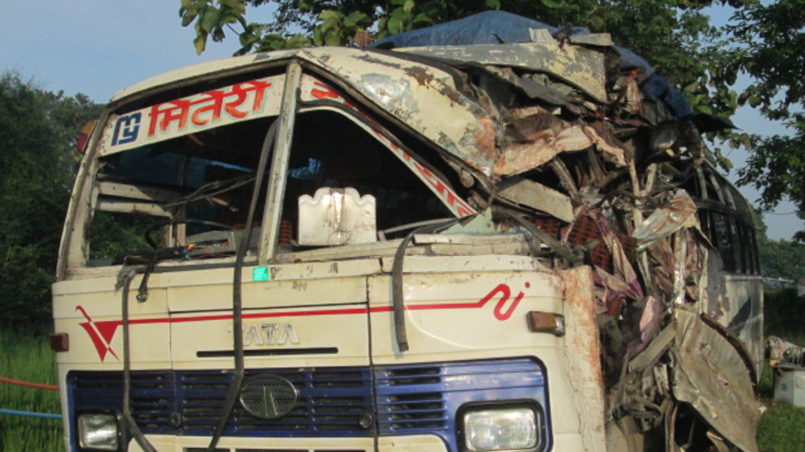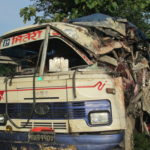The Major Reasons for Road Traffic Injuries in Nepal

Over 130 road fatalities of road traffic injuries were reported in the first one and a half months of the year 2016/17. In the same year, at least 42 people were killed in a bus accident in Kavrea (a town near Kathmandu), 39 people were killed in a bus accident in Jajarkot (a remote district in province no. 6 in Nepal), 7 people were killed in the Jeep accident at eastern Rukum (a remote district in province no. 5 in Nepal), 5 people were killed in a bus accident on the way to Dang (a developing district in province no 5 in Nepal). Many other such reports have still not been updated.
Over an average of 1,800 persons die in road accidents across the country every year. According to the police I spoke to, many accidents go unreported mainly because the parties involved settle matters themselves. Also, accidents where people suffer minor injuries or where there is only damage to vehicles are often settled at the accident site and are not reported to the police, in my opinion.
The central region topped the chart with 691 deaths, while the western region recorded 520, the eastern region 446, the mid-western region 228 and the far western region 121 deaths in 2015/16. Similarly, 166 people were killed in the Kathmandu valley alone. According to the Motor Vehicle and Transport Act 1993, those violating traffic rules and regulations and causing death can be penalised with Nrs. 100,000 to 500,000 depending on the individual case.
In Nepal, the insurance system for passengers, vehicle owners/drivers, and third-party insurance is very underdeveloped. If an accident happens due to the negligence of the driver, he/she will be sent to prison but if accidents happen and the driver was not at fault, s/he will be released after having paid a fine. The government has increased the fines for violation of traffic rules by an amendment to section 164 of the 1993 Act, which came into effect from May 14, 2015.
Since Kathmandu is Nepal’s capital, with a high number of inhabitants and vehicles, the number of accidents is also correspondingly high. According to the Metropolitan Traffic Police Division Report, in 2011/12, Kathmandu recorded the highest number of accidents – 5,069 while the figures for the years 2009/10, 2010/11 and 2012/13 were 4,770, 4,104 and 4,914.
There are multiple causes of road traffic accidents, mainly related to drivers’ behavior, the mechanical conditions of the vehicle(s) involved, and road conditions. The high number of bus-only crashes indicates driving-related issues as probable causes. Such issues include speeding, overtaking, overloading, overwork, and the consumption of alcohol. Indeed, data on traffic accidents suggest that driving-related issues are far more relevant than mechanical faults or pedestrian negligence.
Nepal has more than 3,000 villages where most of the roads are not paved and the situation is worse in hilly regions. For this reason, a large number of buses go off the roads as they are overloaded with passengers. The other reason for the high number of traffic injuries is also the increasing number of vehicles. The rapid increase in deaths, especially from 2007 onwards, may be attributed to the overall increase in vehicles as well as road tracks, mostly earthen roads in hilly districts, which lead to delays in accessing hospital emergency services in the event of a crash.
Therefore, it seems important to ensure the maintenance of village roads in districts in order to ensure the safe operation of local buses. Traffic education should also be strengthened through public campaigning and safety promotion in schools targeting young novice motorcyclists in major cities of Nepal.
The number of people who lose their lives in Nepal is far too high. The Nepal government and all other responsible authorities need to be aware of this silent epidemic in Nepal. The syndicate system in Nepal is another cause of road traffic injuries. This system has prevented free and healthy competition among vehicle companies in Nepal. Therefore, people, willingly or unwillingly, are forced to use the only service which is lacking in quality and security.
In Nepal, especially during the large festivals like Dashain, Tihar, and Chhath, millions of people travel from the Kathmandu valley to celebrate the festivals in their villages with their families. At this time, buses are extremely overcrowded and every year at least one bus crashes, resulting in many people losing their lives at the peak of the festival season. Therefore, public awareness and campaigns against road traffic injuries must be initiated very broadly all over the country.
Pressure must also be exerted on political parties to solve and control this problem in Nepal because the occurence of major bus accidents in Nepal has become commonplace. The punishment and the penalty system for those who cause accidents is not properly exercised in Nepal. If the person who causes an accident is rich or has powerful links with the political parties, then they get bail within hours.
Many things have to be improved in order to reduce the incidence of road traffic accidents in Nepal. Many plans and policies have been proposed, but the implementation of them has not been at all successful.
Credits
| Image | Title | Author | License |
|---|---|---|---|
 |
Miteri_yatayat_Accident | Krish Dulal | CC BY-SA 3.0 |
